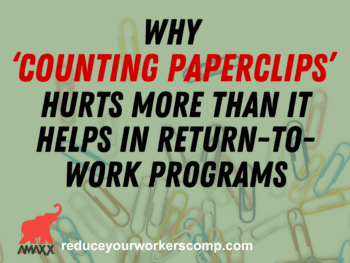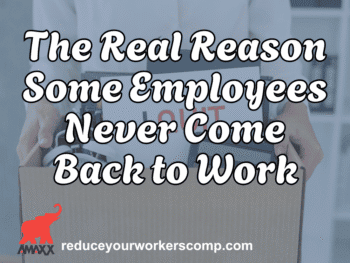Hello. Michael Stack here, Principal of Amaxx, founder of COMPClub and co-author of Your Ultimate Guide to Mastering Worker’s Comp Costs. Today I want to look at 2 extremes. One in the case of an Olympic return to work success, in comparison to a claim with the same injury that would cause a permanent disability and fall in the category of Workers’ Compensation of the 5% of claims that are causing 80% of the cost.
Identical Injury Can Cause Two Very Different Outcomes
Let’s take a look first at the success case. This was the story of Ellie Downie. She’s an Olympic gymnast on the Great Britain women’s gymnastics team. She was performing her floor exercise in the qualifying round, and through the course of her tumbling she over rotated and landed on the back of her neck. It looked like a very gruesome injury, but in true Olympic spirit Ellie tried to get up and continue her performance. She felt dizzy and had to leave the arena. I believe at that moment she believed that her Olympic dream was over. Only a few short hours later Ellie returned to the arena performed 2 vaults and helped Great Britain qualify for the team final.
In the Workers’ Compensation world we would qualify that as a tremendous return to work success following an injury. That’s the success story. There’s also a case where that same injury could lead to a permanent disability. ACOEM published a white paper called, “The Guide to Preventing Needless Work Disabilities.” In that paper they stated that only a small percentage of injuries actually by medical necessity need to be out of work. The vast majority of individuals who are injured can get back to work in some capacity, causing a much faster healing and recovering time. That’s the other extreme; the permanent disability side.
What are the elements that were involved in Ellie’s injury that she had over here that are not existent and maybe causing these problems that we can recognize in the Work Comp industry and then try to get ahead of those claims to prevent that small percentage of claims that cause the highest dollar amounts?
OLMYPIC Return To Work Success Factors
Let’s take a look at these factors that Ellie had. She had immediate medical attention. If you look at the footage here you can see that her training staff, the medical staff rushed to her aid. She had immediate medical attention. That was factor number 1. Factor number 2; she had tremendous support. She had support of her teammates, she had support of her family, she had support of her country, and she really had the support of the entire arena and the entire world that was watching that event, because we know the passion and preparation that goes into that and were rooting for her to get back to the arena. She had tremendous support. Third piece; she had personal skills. She was an Olympian. She had the Olympic spirit. She had the pain of training, the passion and dedication to get ready and prepare for that event. The same skills were able to let her handle the stress of that injury and have the motivation to get back to work.
Permanent Disability Factors
Now, the reality is when we’re watching the Olympic Games we realize that we’re not all Olympians and there are things that we can learn from that. Let’s take a look at this case where that same exact injury that happened to Ellie not in the context of the Olympics, but in the context of an everyday working Joe American. The same injury occurs and let’s look at what happens when these factors are not at play. Maybe that claim doesn’t get reported. Maybe the claim happens and that person feels like they’re a tough individual or maybe there’s some different elements at play in the workforce that they feel fearful to report the claim, so the claim goes unreported. There’s no medical attention at the time of injury. Both of these factors are not present; the claim is not reported and there’s no immediate medical attention.
Immediate Medical Attention
There was a story that was reported later that Ellie reported that she was actually a lot better than she thought, which allowed her to in order to come back to work, in order to perform that vault. That immediate medical attention, that fear, that anxiety that she felt even as an Olympian with all this stuff going for her, she still had that fear and anxiety that she would not be able to return. In the claim of a really standard American claim goes unreported that fear then accelerates; that anxiety accelerates and it’s not addressed in order to be able to get that injury going in the right direction.
Support
Next thing here; let’s take a look at support. I’m going to do this as transitional duty/work support and then family and friends. Ellie obviously had this in spades being an Olympian and having the support of her country and really of the entire world. From a transitional duty position maybe there’s no job available. Maybe someone at the employer has no injury response procedure. They had no communication plans in place. This person is left to be on their own and maybe they don’t have much family and maybe they don’t have many friends. These skills and the support system that enables an individual to recover and get back to work is nonexistent on this side.
Personal Skills
Then let’s talk about these personal skills and this motivation. Maybe this person doesn’t have this. Maybe there’s some depression, maybe there’s some anxiety, maybe there’s some psychiatric mental underlying mental conditions that are existent and present in this person’s life that are not addressed, that are left unnoticed. In this case tremendous system support, medical attention, and those personal skills in order to get back to work, in this case none of this is present. Leaving this claim now to be what could have been back to work in a matter of a few hours now leaves this person disabled for the rest of their life and now falls into that category of one of those a very small percentage of claims that cost the most amount of money years and years and becomes a permanent disability or a permanent partial disability claim costing hundreds of thousands of dollars that could have been prevented.
Prevent Needless Disability
When we look at this example, when we look at this case, and we look at both extremes of what was in play at that time of injury, putting these systems in place, getting those claims reported, having that transitional duty, putting that injury management process in place that I talk about on this blog, extraordinarily important to control your Workers’ Compensation cost and create the best Olympic outcomes.
Remember your success in Workers’ Compensation is defined by your integrity, So, be great!
Author Michael Stack, Principal, COMPClub, Amaxx LLC. He is an expert in workers compensation cost containment systems and helps employers reduce their work comp costs by 20% to 50%. He works as a consultant to large and mid-market clients, is co-author of Your Ultimate Guide To Mastering Workers Comp Costs, a comprehensive step-by-step manual of cost containment strategies based on hands-on field experience, and is founder of COMPClub, an exclusive member training program on workers compensation cost containment best practices. Through these platforms he is in the trenches on a working together with clients to implement and define best practices, which allows him to continuously be at the forefront of innovation and thought leadership in workers’ compensation cost containment. Contact: mstack@reduceyourworkerscomp.com.
©2016 Amaxx LLC. All rights reserved under International Copyright Law.
Do not use this information without independent verification. All state laws vary. You should consult with your insurance broker, attorney, or qualified professional.















